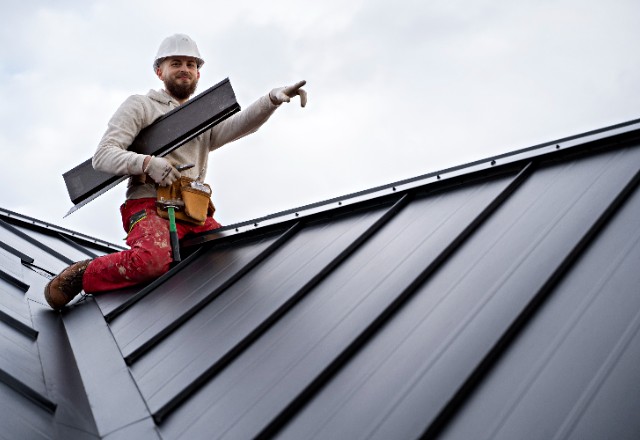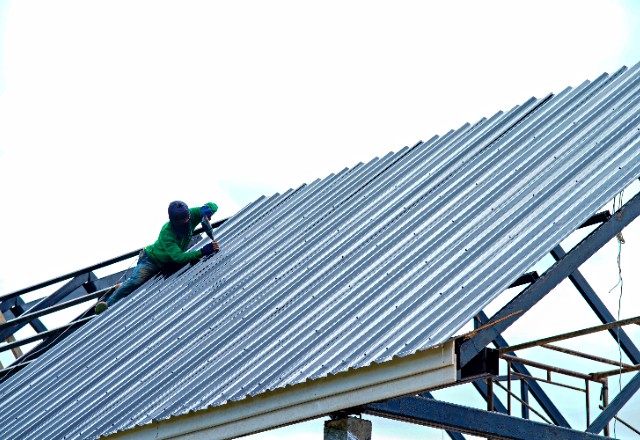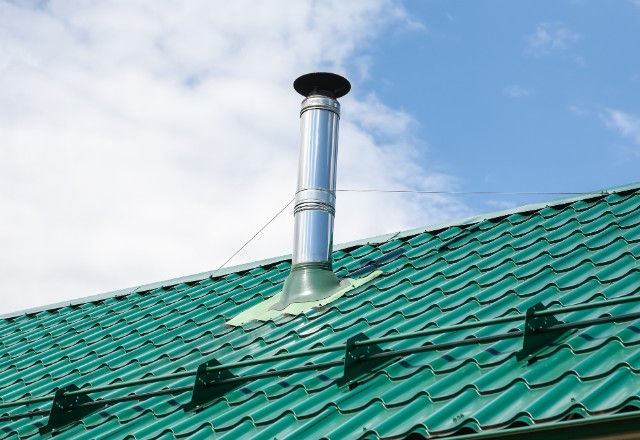Investing in a metal roof can offer numerous benefits, including durability, energy efficiency, and aesthetic appeal. However, understanding the costs involved is crucial for homeowners looking to upgrade to a metal roofing system. In this article, we’ll delve into the various factors influencing metal roofing prices, providing an insightful guide on what to anticipate when considering this durable and versatile roofing option.
Disclaimer: This article is provided for informational purposes only and does not constitute professional advice. For expert advice on how to best meet your roofing needs, we recommend consulting with the experienced professionals at Advance Roofing LLC. With years of experience in the Spokane, WA area, our team is always happy to help!
How Much Does Metal Roofing Cost?
Metal roofing costs vary based on several factors such as the type of metal used, installation complexity, area size, labor charges, and location. To provide a general idea:
Cost Factors:
Metal Type: Different metals like aluminum, steel, copper, and zinc have varying costs. For instance, aluminum roofs can range from $9 to $12 per square foot, while copper roofing may be priced from $15 to $30 per square foot due to its durability and unique appearance.
Installation Expenses: Labor costs significantly impact the total expense. Professional installation ensures quality but adds to the overall cost. Prices may differ based on the complexity of the installation process.
Roof Size: The area size and design complexity affect the overall cost. Larger roofs with intricate designs will generally cost more due to increased material and labor requirements.
Additional Factors: Other factors like the roof’s pitch, underlayment materials, location (regional variations in labor and material costs), and the selected roofing style or finish contribute to the final cost.
Benefits of Metal Roofing:
Despite the higher initial investment, metal roofing provides various long-term benefits. It offers exceptional durability, resistance to weather elements, energy efficiency, and lower maintenance costs compared to traditional roofing materials. Additionally, it often comes with extended warranties due to its longevity.
The cost of metal roofing varies widely depending on the type of metal chosen, the complexity of the installation, and various influencing factors. It’s recommended to consult with a professional roofing contractor for an accurate estimate tailored to your specific requirements and location.
Cost Comparison of Metal Roofing
When considering a metal roof for your property, the choice of material plays a pivotal role not just in aesthetics but also in overall cost. Metal roofing offers durability, longevity, and a range of styles, but the cost can vary significantly based on the type of metal chosen. Understanding the nuances and cost differences between various metal roofing materials—such as aluminum, copper, steel, tin, and zinc—can greatly impact your decision-making process. This detailed cost comparison will delve into the unique advantages, price points, and characteristics of each metal roofing option, aiding you in making an informed choice that aligns with your preferences and budget for a durable, high-quality roofing solution.
Aluminum Roofing:
- Advantages: Lightweight, corrosion-resistant, durable, and suitable for coastal regions.
- Types: Available in various forms, including standing seam panels, shingles, and tiles.
- Cost: Ranges from $9 to $12 per square foot. Moderately priced due to its durability and resistance to rust.
Copper Tiles:
- Advantages: Distinctive appearance, exceptional durability, and longevity (can last for centuries).
- Types: Available as copper tiles for roofing with varying designs.
- Cost: Priced between $15 to $30 per square foot, making it one of the most expensive options due to its longevity and aesthetic appeal.
Steel Shingles and Tiles:
- Advantages: Durable, fire-resistant, available in various designs, and relatively affordable.
- Types: Offered in both shingles and panels, replicating the appearance of traditional roofing materials.
- Cost: Typically priced from $5 to $12 per square foot, making it a cost-effective alternative to other metal roofing materials.
Tin Panels:
- Advantages: Corrosion-resistant and lightweight, suitable for agricultural or industrial buildings.
- Types: Mostly available as corrugated tin panels, offering cost-effective roofing solutions.
- Cost: Moderately priced at approximately $5 to $8 per square foot due to its affordability and relatively straightforward installation.
Zinc Panels:
- Advantages: Exceptional longevity, malleability, and self-healing properties.
- Types: Available in various panel designs, often used in contemporary architecture.
- Cost: Priced between $10 to $15 per square foot, slightly higher than other options due to its durability and aesthetic appeal.
While aluminum and steel offer affordability and durability, copper and zinc stand out for their exceptional longevity and unique appearance. The choice depends on individual preferences, budget, desired aesthetic, and specific project requirements. It’s advisable to consult with a professional roofing contractor to determine the best-suited material based on your needs and budget constraints.

Other Factors That Influence Metal Roof Cost
Labor
Labor plays a crucial role in determining the overall cost of installing a metal roof. Several factors associated with labor influence the total expenses:
Complexity of the Installation: The complexity of the roof design and structure affects labor costs. Complicated layouts, slopes, angles, and unique architectural features might require more time and expertise, thereby increasing labor expenses.
Skill and Expertise: Highly skilled and experienced labor comes at a higher cost. Quality workmanship is vital for a durable and well-installed metal roof. Hiring skilled professionals might increase upfront costs but can prevent potential issues and repair costs in the long run.
Roof Size and Surface Preparation: Larger roofs demand more labor, materials, and time for installation. Additionally, the preparation of the roof surface, such as removing the existing roof, repairing underlying structures, or adding insulation, impacts labor costs.
Location and Accessibility: The location and accessibility of the property can affect labor expenses. Difficult-to-access areas or properties in remote locations may require more effort, time, and resources, impacting labor costs.
Labor Rates: Labor rates vary depending on geographic location, local market conditions, and the availability of skilled roofers. Areas with higher living costs or where skilled labor is in high demand typically have higher hourly rates for roofing installation.
Preparation and Cleanup: Preparing the site before installation and cleaning up afterward are essential tasks that require time and effort. They contribute to labor costs, especially if extensive work is needed to clear the area or dispose of debris.
Additional Work: Sometimes, unexpected issues might arise during installation, such as hidden damage or structural concerns. Addressing these issues may require extra labor, impacting overall costs.
Efficiency of the Crew: The efficiency and productivity of the roofing crew can affect labor costs. A more experienced and efficient team might complete the project faster, reducing labor expenses.
It’s crucial to hire reputable contractors who provide detailed estimates, transparent breakdowns of costs, and ensure proper licensing and insurance. While labor costs are a significant part of the overall expense, investing in skilled and reliable professionals ensures a quality installation that can add value and durability to your property.
Location
Location can significantly impact the cost of installing a metal roof due to various regional factors:
Regional Pricing Variations: Different regions have varying costs of living and market demands, which affect labor rates, material costs, and overall expenses. Urban areas or regions with high living costs generally have higher roofing costs compared to rural or less populated areas.
Local Building Codes and Regulations: Each locality has its own building codes and regulations concerning roofing materials, installation methods, and safety standards. Compliance with these regulations might involve additional expenses, such as specific materials or permits, thereby influencing overall costs.
Accessibility and Transportation: The accessibility of the installation site and transportation logistics also impact costs. Difficult-to-reach areas, distant locations, or properties with limited access may require additional effort, time, and resources, potentially increasing labor costs.
Climate and Weather Conditions: Weather patterns and climate conditions in a particular region can influence roofing costs. Areas prone to extreme weather conditions, such as high winds, heavy rainfall, or snow loads, may require specific roofing materials or additional structural reinforcements, affecting overall expenses.
Local Market Competition: The level of competition among roofing contractors in a specific area can impact pricing. Areas with a high number of roofing companies might offer more competitive prices due to increased market competition.
Supply and Demand of Roofing Materials: The availability and demand for roofing materials in a particular region can affect their prices. If a specific type of metal roofing material is in high demand but low supply, it might lead to higher costs.
Geographical Factors: Geographical conditions such as altitude, proximity to water bodies, seismic activity, or environmental factors can influence the choice of materials and installation methods, thereby impacting costs.
Local Labor Availability: The availability of skilled roofing labor in a specific area can affect labor costs. Regions with a shortage of skilled labor might have higher labor rates due to increased demand.
Considering these location-based factors is essential when estimating metal roofing costs. Hiring local contractors familiar with the area’s requirements and conditions can help provide more accurate estimates and ensure compliance with local building codes and regulations.
Pitch
The roof pitch, which refers to the steepness or slope of the roof, can indeed impact the cost of installing a metal roof. Here’s how:
Complexity of Installation: Steeper roof pitches are more challenging to work on compared to roofs with lower slopes. Working on a high-pitched roof requires additional safety measures, specialized equipment, and extra labor due to the difficulty of access. Contractors may need additional safety harnesses, scaffolding, or other safety gear, leading to higher labor costs.
Material Requirements: High-pitched roofs often require more materials. The steeper the roof, the more surface area it covers. This additional coverage demands more roofing materials, contributing to higher material costs.
Installation Challenges: The complexity of installing a metal roof on a steep pitch increases the time and effort needed for the installation process. The intricate nature of working on a steep slope requires specialized expertise and skill, resulting in higher labor costs.
Safety Precautions: Working on a steep roof involves a higher risk of accidents and falls. To ensure safety compliance, contractors may need to implement additional safety measures, increasing the overall project cost.
Underlayment Requirements: Steeper roofs might require specific underlayment or decking materials to prevent water penetration and provide adequate support. These additional materials can add to the overall cost of the roofing project.
Roofing Material Selection: Certain metal roofing materials might be better suited for specific roof pitches. Some materials are more adaptable to steeper slopes, while others are more appropriate for lower pitches. The choice of material for a particular pitch can affect material costs.
In summary, a steeper roof pitch generally translates to increased costs due to the complexities involved in installation, higher material requirements, additional safety measures, and specialized labor needed to work on such roofs. Therefore, the pitch of the roof is an essential factor to consider when estimating the cost of installing a metal roof.
Underlayment
The underlayment in a metal roofing system plays a crucial role in protecting the roof deck from elements such as moisture, water intrusion, and extreme weather conditions. Here’s how underlayment can influence the cost of a metal roof:
Material Quality: The quality of underlayment materials significantly impacts the overall cost. High-quality underlayment materials, such as synthetic or rubberized membranes, are more durable and provide better protection against water infiltration, but they can be more expensive compared to traditional asphalt-saturated felt.
Underlayment Type: Different types of underlayment exist, and their costs vary. For instance, peel-and-stick membranes and self-adhering underlayments offer easier installation but tend to be more expensive than traditional felt underlayments.
Roof Size and Complexity: Larger roofs or roofs with complex designs, such as those with multiple angles or dormers, may require more underlayment material. The size and intricacy of the roof directly impact the quantity of underlayment needed, influencing the overall cost.
Weather Protection and Insulation: Some underlayment materials offer enhanced protection against extreme weather conditions and better insulation properties. These specialized underlayments, while providing additional benefits, often come at a higher cost compared to basic underlayment options.
Code and Manufacturer Requirements: Certain building codes and manufacturer recommendations specify the type and quality of underlayment required for specific roofing materials or climates. Compliance with these standards may necessitate the use of specific, often more expensive, underlayment materials.
Labor and Installation Costs: The installation of underlayment involves labor costs. Some underlayment types might require additional labor or specialized installation techniques, impacting the overall cost of the roofing project.
In summary, the choice of underlayment material, the roof’s size and complexity, weather protection requirements, and adherence to building codes all influence the cost of the metal roofing system. While underlayment might contribute to a fraction of the total roofing cost, it’s a critical component that can significantly affect the roof’s durability and performance.
Style
The style of a metal roofing system can significantly impact its cost due to various factors associated with different styles. Here’s how the style of metal roofing influences its cost:
Complexity and Design: Intricate roof designs, such as standing seam roofs or architectural panels, often involve more labor and material costs. These styles require specialized installation techniques and custom fittings, which can increase the overall expense compared to simpler styles like corrugated panels.
Material Variation: Different roofing styles might utilize varying materials or finishes. For instance, while some styles use basic steel panels, others might incorporate premium-grade metals like copper or zinc, contributing to higher material costs.
Customization and Finishes: Certain roofing styles offer customization options and finishes, such as color variations, paint coatings, or textured designs. Customized or special finishes add to the overall cost compared to standard, plain metal roofing materials.
Durability and Longevity: Some roofing styles are known for their exceptional durability and longer lifespan. Styles that incorporate higher-quality materials or coatings designed to withstand harsh weather conditions and resist corrosion often come with a higher upfront cost but offer better long-term value.
Architectural Appeal: Roofing styles that enhance the architectural aesthetics of a building, such as metal shingles replicating traditional roofing materials like slate or wood shakes, may be more expensive due to their visual appeal and resemblance to high-end materials.
Installation Complexity: The complexity of installing certain roofing styles can increase labor costs. Styles that require intricate detailing, precise fitting, or specific installation techniques may demand more time and skilled labor, affecting the overall cost.
In conclusion, the style of a metal roof influences its cost due to material variation, customization options, installation complexity, architectural appeal, and durability characteristics. Homeowners should consider their preferences, budget, and long-term investment when choosing a metal roofing style. Each style has its advantages and associated costs, making it essential to weigh these factors when deciding on the most suitable roofing option.
 Benefits of Metal Roofing
Benefits of Metal Roofing
Metal roofing offers various benefits that make it a preferred choice for many homeowners. Here are some advantages associated with different types of metal roofing:
Durability and Longevity: Metal roofing, whether metal shingles, galvanized steel, stainless steel, or copper roofs, is highly durable and can withstand harsh weather conditions, including heavy rain, strong winds, and hail. Their robust construction ensures a long lifespan, lasting anywhere from 40 to 70 years or more, depending on the type of metal roof and proper maintenance.
Energy Efficiency: Metal roofs reflect solar radiant heat, reducing cooling loads during hot summers. This inherent reflective property can contribute to lower energy costs by keeping the interior cooler, especially when combined with proper insulation and ventilation.
Aesthetic Appeal and Versatility: Metal roofing comes in various styles, colors, and finishes, such as metal shingles or seam roofs, providing homeowners with a wide range of design options to complement their homes. The versatility of metal roofing allows for replicating the look of traditional roofing materials like asphalt, wood, slate, or clay tiles, offering an appealing aesthetic to any property.
Low Maintenance Requirements: Unlike other roofing materials, metal roofs typically require minimal maintenance. They are resistant to cracking, fading, and corrosion, reducing the need for frequent repairs or replacements. Periodic inspections and basic maintenance ensure the roof’s longevity.
Environmentally Friendly: Metal roofing is often made from recycled materials and is itself recyclable at the end of its lifespan. This eco-friendly aspect makes it a sustainable choice for environmentally conscious homeowners seeking greener roofing alternatives.
Long-Term Cost Savings: Although the initial cost of metal roofing might be higher than some traditional roofing materials, the long-term cost benefits outweigh the initial investment. Metal roofs offer better durability, lower maintenance costs, and potential energy savings, making them a cost-effective option over time.
The benefits of metal roofing, whether it’s galvanized steel, stainless steel, copper roofs, or metal shingles, include exceptional durability, energy efficiency, aesthetic appeal, low maintenance, environmental friendliness, and long-term cost savings, making them an attractive choice for residential and commercial roofing projects.
Conclusion
In conclusion, the cost of metal roofing varies based on several factors that should be carefully considered when planning a roofing project. Factors such as square footage, the type and quality of metal used, installation intricacies, labor expenses, and additional elements like underlayment, style, and pitch all contribute to the overall cost of metal roofing.
For accurate estimates, homeowners and contractors should consider obtaining quotes from reliable roofing professionals who can assess the specific needs of the project. These professionals can provide detailed cost breakdowns based on the requirements and preferences, ensuring that the investment aligns with the desired outcomes while staying within budgetary constraints.



 509-201-4190
509-201-4190



 Benefits of Metal Roofing
Benefits of Metal Roofing